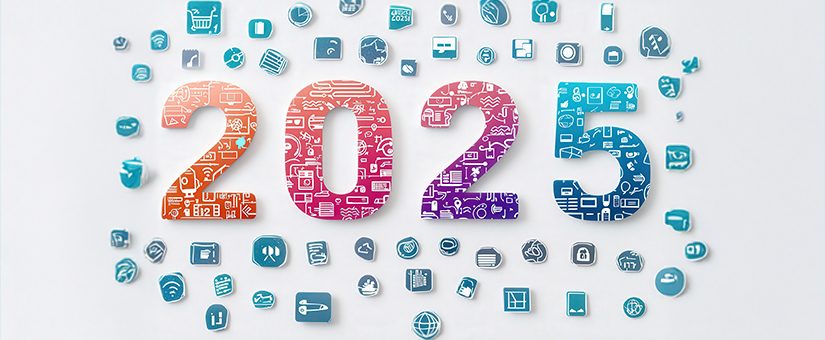
Top 10 Social Media Trends in 2025
- On 27/01/2025
- AI, Alternative Social Platforms, Digital Marketing Trends, Gen Z, influencer marketing, mental health, Privacy Policies, VR/AR, Алтернативни социални платформи, дигитален маркетинг, Маркетинг с инфлуенсъри, поколение Z, Политики за поверителност, психично здраве, Социална търговия, Съдържание в кратка форма, Създаване на съдържание с AI, Тенденции в социалните медии 2025
Is “long-form” content making a comeback, or is it the opposite?
Hello, Gen Z! Will the authenticity of influencers still matter? ✨
Will alternative social platforms gain momentum and replace the big players?
How will privacy policies adapt to increasing risks of fraud?
A focus on mental health, sustainable business practices, and more.
Let’s explore the top 10 trends for 2025:
1. Dominance of Short-Form Content
In 2024, TikTok increased video lengths from 15 seconds to 10 minutes, while Instagram Reels, Snapchat, and YouTube allowed videos of up to 3 minutes. Claims that long-form content is returning have sparked various interpretations.
Podcasts and in-depth articles remain popular for those seeking more meaningful and informative content, but short, concise content will continue to dominate and maintain its appeal throughout 2025.
80% of online traffic comes from video views.
87% of marketers report a direct increase in sales through video.
73% of consumers prefer short videos to learn about products or services.

Gen Z
2. Focus on Gen Z (1997–2012)
Generation Z, or “Digital Natives,” is the first generation born into a world with mobile technology. They range in age from 8 to 23 and account for 30% of the global population.
Globally oriented, entrepreneurial, socially engaged, and independent, this generation is shaped by the Internet, social media influencers, and streaming platforms.
According to a MediaTool report, 75% of Gen Z uses mobile devices as their primary technology. For them, mobile phones are a gateway to shopping, social networking, gaming, global news, and mental and physical health care.
👉 Read more about the “Specifics of generational values, behavior, and communication” on our website: http://bit.ly/4g4JYz1
3. Omnichannel Integration and Growth
Omnichannel commerce has evolved to meet consumers’ demands for flexibility and convenience. It’s no longer enough to simply exist online or in-store.
Customers expect seamless engagement with brands across multiple channels, anytime and anywhere. As a result, shopping directly through social platforms is becoming the norm, providing users with a smooth and integrated shopping experience.
74% use social media to decide what to buy.
80% are more likely to purchase online with personalized experiences.
73% shop using a mix of methods (online, in-store, mobile).

Influencers
4. The Authenticity of Influencers
Trust has become the new currency of influence as more consumers discover products through social platforms.
Traditional celebrities are increasingly replaced by micro-influencers with smaller but highly engaged and loyal audiences. There is a growing demand for more authentic influencers who genuinely engage with their audience.
5. AI-Driven Content Creation
According to Microsoft, AI-driven content creation jumped from 55% in 2023 to 75% in 2024, delivering a return of $3.70 for every $1 invested. AI is expected to contribute $2.7 trillion to Europe’s GDP by 2030.
By 2025, 90% of online content is expected to be AI-generated (Europol Innovation Lab). While AI makes content creation faster and more efficient, human oversight is essential to avoid errors, incomplete information, or unsatisfactory results.
6. Evolving Privacy Policies
AI continues to transform services, but growing concerns about data privacy are driving new regulations and consumer expectations.
AI can automate threat detection, but it lacks the ability to interpret unique contexts like humans. In 2025, AI will remain a supportive tool rather than a replacement for human expertise in cybersecurity.
7. Alternative Social Networks
With increasing concerns about privacy and ethics, users are turning to decentralized and community-focused platforms. Mastodon (150M users), Bluesky (14.5M users), and Threads (275M users) offer greater control over personal data and content than traditional platforms like X (formerly Twitter).
Alternatives to X: Bluesky, Threads, Mastodon
Alternatives to Facebook: NextDoor
Image-based apps: Lemon8, BeReal, Locket

VR
8. AR + VR: The Long-Term Formula for Success
The global AR and VR market was valued at $30 billion in 2022 and is expected to exceed $520 billion by 2031 (Skyquest).
Brands are increasingly integrating AR and VR into user experiences, from Instagram and TikTok to Facebook. IKEA’s VR app is an excellent example, allowing customers to visualize furniture in their homes before purchasing.
Organizations that adopt AR and VR trends today will lead the market in the future.
9. Sustainability and Social Responsibility
Consumers increasingly favor brands that prioritize eco-friendliness and social responsibility.
In 2025, transparency in production and sustainability will be the benchmark for success. Sporadic campaigns are no longer enough—authenticity must align with a brand’s core values.
10. Mental Health Focus

Meditation App
Social media is breaking down stigmas surrounding mental health by encouraging open conversations and offering free resources.
For example the meditation app market alone grew to $1.86 billion in 2024 and is expected to reach $2.26 billion by 2025.
93%: AI algorithms can predict psychosis with high accuracy.
44%: People with mental illnesses lack treatment due to stigma, cost, or limited access.
70%: Feel comfortable seeking mental health support from chatbots.
One thing is certain: 2025 will be an exciting year!
Which social media trend are you most excited to follow?
Share your thoughts in the comments!



